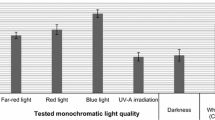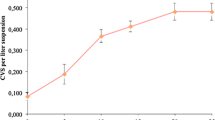Abstract
Incubation of suspension-cultured slash pine (Pinus elliotti Engelm.) cells with living mycelial plugs or homogenized, washed and autoclaved mycelium of Cronartium quercum f.sp. fusiforme led to rapid clouding of the medium and visible inhibition of cell growth with only a slight increase in cell mortality. Purified chitin elicited similar changes in cloudiness and growth. Chitin treatment concentrations of up to 1 mg ml-1 showed only slight changes in viability over several days (as with the mycelium and mycelial extract). In contrast, chitosan concentrations of as low as 60 μgml-1 showed cell mortality and browning, with a complete ‘hypersensitive’ response and over 90% cell death occurring within 48 h at between 180 and 270 μ ml-1 chitosan amendment. Phloroglucinol staining showed the presence of lignin-like compounds in the medium and lignin-like compounds were elevated in the cell walls of the chitin, chitosan and mycelium elicited suspension cultures as compared to controls.
Similar content being viewed by others
References
Amerson HV, Mott RL (1978) Technique for axenic production and application of Cronartium fusiforme basidiospores. Phytopathology 68: 673–675
Cramer CL, Ryder TB, Bell JN, Lamb CJ (1985) Rapid switching of plant gene expression induced by fungal elicitors. Science 227: 1240–1243
Durzan DJ (1985) Cell and tissue culture in forest industry. In: Bonga JM, Durzan DJ (Eds) Tissue Culture in Forestry (pp 36–71) Martinus Nijhoff/Dr W Junk Publ, Boston
Farmer EE (1985) Effects of fungal elicitor on lignin biosynthesis in cell suspension cultures of soybean. Plant Physiol 78: 338–342
Fritensky B, Riggleman RC, Wagoner W, Hadwiger LA (1985) Gene expression in susceptible and disease-resistant interactions of peas induced with Fusarium solani pathogens and chitosan. Physiol Plant Path 27: 15–28
Hahn MG, Darvill AG, Albersheim P (1981) Host-pathogen interactions. XIX. The endogenous elicitor, a fragment of plant cell wall polysachharide that elicits phytoalexin accumulation in soybeans. Plant Physiol 68: 1161–1169
Jensen WA (1962) Botanical Histochemistry. Freeman and Co, San Fransisco/London
Kohle H, Young DH, Kauss H (1984) Physiological changes in suspension-cultured soybean cells elicited by treatment with chitosan. Plant Sci Lett 33: 221–230
Kombrink E, Hahlbrock K (1986) Responses of cultured parsley cells to elicitors from phytopathogenic fungi. Plant Phys 81: 216–221
Kurosaki F, Tashiro N, Nishi A, (1987) Induction, purification and possible function of chitinase in cultured carrot cells. Physiol Mol Plant Path 31: 201–210
Lesney MS, Johnson JD, Korhnak T, McCaffery MW (1988) In vitro manipulation of slash pine (Pinus elliottii). In: Hanover JW, Keathley DE (Eds) Genetic Manipulation of Wood Plants (pp 43–55) Plenum Press, New York
Miller RH, Berryman AA, Ryan CA (1986) Biotic elicitors of defense reactions in lodgepole pine. Photochemistry 25: 611–612
Miller T, Cowling EB, PowersJr HR, Blalock TE (1976) Types of resistance and compatibility in slash pine seedlings infected by Cronartium fusiforme. Phytopathology 66: 1229–1235
Pearce RB, Ride JP (1982) Chitin and related compounds as elicitors of the lignification response in wounded wheat leaves. Physiol Plant Path 20: 119
Peleg Y, Koder S, Rokem JS, Chet I, Goldberg I (1987) Phaseollin production in cell suspensions and whole plants of Phaseolus vulgaris. Plant Cell Tissue Organ Culture 9: 207–215
Robersten B (1986) Elicitors of the production of lignin-like compounds in cucumber hypocotyls. Physiol Plant Path 28: 137–148
Scheffield RM, Knight HA, McClure JP (1983) The slash pine resource. In: Stone EL (Ed) The Managed Slash Pine Ecosystem pp 4–23 Symposium Proceedings. School of Forest Resources and Conservation, University of Florida, Gainesville
Schmidt RA, Powers HR, Snow GA (1981) Application of genetic disease resistance for the control of fusiform rust in intensively managed southern pine. Phytopathology 71: 993–997
Vance CP, Kirk TK, Sherwood RT (1980) Lignification as a mechanism of disease resistance. Ann Rev Phytopath 18: 259–288
Verma DC, Litvay JD, Johnson MA, Einspahr DW (1982) Media development for cell suspensions of conifers. Proc 5th Int Congr Plant Tissue and Cell Culture, Tokyo, Japan, 11–16 July (p 59–60)
Author information
Authors and Affiliations
Rights and permissions
About this article
Cite this article
Lesney, M.S. Growth responses and lignin production in cell suspensions of Pinus elliottii ‘elicited’ by chitin, chitosan or mycelium of Cronartium quercum f.sp. fusiforme . Plant Cell Tiss Organ Cult 19, 23–31 (1989). https://doi.org/10.1007/BF00037773
Received:
Accepted:
Issue Date:
DOI: https://doi.org/10.1007/BF00037773




